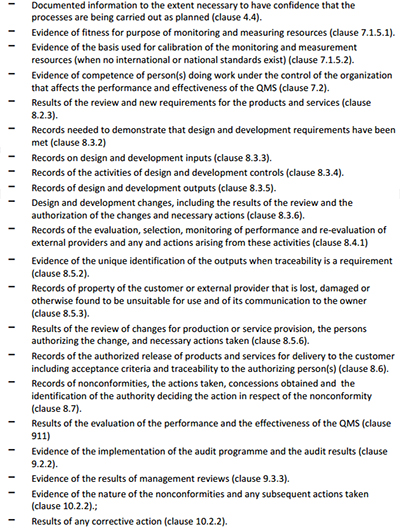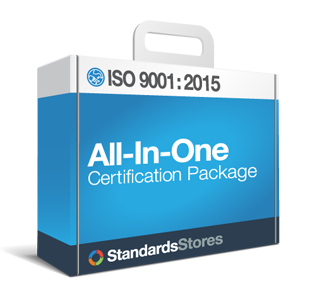ISO 9001 Requires that you maintain control of documents
-
- Approve documents for adequacy prior to issue
- Review, update as necessary, and re-approve documents
- Identify the changes and current document revision status
- Make relevant documents available at points of use
- Ensure the documents remain legible and readily identifiable
- Identify external documents and control their distribution
- Prevent obsolete documents from unintended use
- Apply suitable identification if obsolete documents are retained
Control of Records
Establish and control records as evidence of conformity to requirements and to demonstrate the effective operation of the quality management system.
Establish a documented procedure to define the controls needed for records:
- Identification
- Storage
- Protection
- Retrieval
- Retention
- Disposition
- Keep records legible, readily identifiable, and retrievable.
Product: ISO 9001:2015 Procedures Package
Product: ISO 9001:2015 Forms Package
What Documentation does ISO 9001:2015 Really Require?
While the ISO 9001:2008 version was explicit about documentation, ISO 9001:2015 allows more freedom in how, what, and when to document a quality management process (such as specific procedures).
It appears this evolution is not only to accommodate more modern forms of communication such as video, audio, and other electronic records, but to allow an organization the flexibility to reuse appropriate information, maintain current versions easier, provide broader access/distribution and reduce costs associated with documentation. (Note: This change does not require changing mediums and allows an organization to also reuse existing QMS documentation, as long as it conforms. See explanation below.)
The Changed Nature of ISO 9001 Documentation
The ISO 9001:2015 standard has removed the distinction between documents and records. Both are now called “documented information”. As per ISO’s definition, the term “documented information” refers to information that must be controlled and maintained. Therefore, it expects that you also maintain and control the medium as well as the information. Documented information is used as evidence of conformance.
Having It Your Way (Sort Of)
ISO 9001:2015 essentially allows the organization to tailor the completeness or complexity of documentation to its own situation, as long as it still achieves its overall objectives. The shift does not, however, lessen the requirement for proper documentation. As noted in the standard, “documented information” can be required:
- When information needs to be disseminated or shared.
- To prove (and retain that proof) that a quality process has been completed and what the results were.
- To retain organizational knowledge including:
- Processes
- Specifications and revisions
- Goals and expectations
- Monitoring and measuring
- Analysis, reviews, evaluations, and validations
- Terminology
- Decisions made
- Negotiations
- Notifications
- Authorizations
- Actions taken
- Assets, inventories and property management
- Position descriptions and qualifications
So What Is Required?
ISO 9001:2015 clause 7.5, requires an organization to:
“Maintain documented information to the extent necessary to support the operation of processes and retain documented information to the extent necessary to have confident that the processes are being carried out as planned.”
ISO’s Guidance on the requirements for Documented Information of ISO 9001:2015 provides these guidelines on what to document:
- Documenting critical portions of the quality management system (QMS) such as its scope, key operational processes, policies, and objectives.
- Documenting important, but perhaps less critical information that supports the QMS such as process flowcharts, specific quality and operational procedures, schedules, information collection approaches (i.e. forms, surveys), business plans, etc.
Will a Quality Manual be required?
The short answer is that under ISO 9001:2015, a quality manual will not be required. The ISO 9001:2015 standard does not specify requiring a formal quality manual. However, a quality manual can still satisfy the requirement for documented information concerning:
- The quality policy
- The scope of the QMS
- Information to support quality related processes
In many cases, the information required by the QMS will still be most convenient and accessible if collected, published and maintained through a traditional quality manual format.
Document Maintenance
As noted in section 7.5, the standard still applies traditional rigor in updating, protecting and retaining documents for information that has been deemed a critical part of the QMS (and other related management systems). There are many specific clauses that essentially call for this documentation (see sample section from ISO documented information guidance below) integrity.

While ISO 9001 2015 documentation requirements are less restrictive than previous revisions, there are still specific instances where documented information must be recorded and retained by the organization’s evidence of achieved results, as noted above.
From ISO’s Guidance on the requirements for Documented Information of ISO 9001:2015
What Is Most Important
Whether an organization has an existing QMS or is just starting, the key is to let the processes that are used to meet its goals determine documentation requirements. If documentation that exists can be shown to support the QMS’ processes effectively, then it can and should be used for that goal. If not, then the appropriate level of effort to transform or re-purpose that documentation into the proper function should be applied.
This flexibility does not, however, relieve the organization from being able to prove that it is meeting its quality management goals. As noted above, the standard has many instances where it calls for specific evidence of conformity. Documentation must accordingly be accurate, objective and current in this regard, and in practice, must stand up to the scrutiny that a properly executed external audit will demand. So, while ISO 9001:2015 is more accommodating regarding documentation directives, the discipline used in compiling previous revision’s quality management system requirements may still be a viable approach.
Please note that certain text from the ISO 9001 standard is only used for instructional purposes. Standard Stores recognizes and respects the International Organization for Standardization (ISO) copyright and intellectual property guidelines.
Gap Analysis Service
A consultant can save you time by performing a gap analysis for you. They are well versed in all of the ISO 9001:2015 requirements, and will help you focus in on the areas of your organization that need improvement to achieve certification. (Remote analysis also available.)


